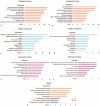Identifying key genes and small molecule compounds for nasopharyngeal carcinoma by various bioinformatic analysis
- PMID: 34664875
- PMCID: PMC8448020
- DOI: 10.1097/MD.0000000000027257
Identifying key genes and small molecule compounds for nasopharyngeal carcinoma by various bioinformatic analysis
Abstract
Nasopharyngeal carcinoma (NPC) is one of the most prevalent head and neck cancer in southeast Asia. It is necessary to proceed further studies on the mechanism of occurrence and development of NPC.In this study, we employed the microarray dataset GSE12452 and GSE53819 including 28 normal samples and 49 nasopharyngeal carcinoma samples downloaded from the Gene Expression Omnibus(GEO) to analysis. R software, STRING, CMap, and various databases were used to screen differentially expressed genes (DEGs), construct the protein-protein interaction (PPI) network, and proceed small molecule compounds analysis, among others.Totally, 424 DEGs were selected from the dataset. DEGs were mainly enriched in extracellular matrix organization, cilium organization, PI3K-Akt signaling pathway, collagen-containing extracellular matrix, and extracellular matrix-receptor interaction, among others. Top 10 upregulated and top 10 downregulated hub genes were identified as hub DEGs. Piperlongumine, apigenin, menadione, 1,4-chrysenequinone, and chrysin were identified as potential drugs to prevent and treat NPC. Besides, the effect of genes CDK1, CDC45, RSPH4A, and ZMYND10 on survival of NPC was validated in GEPIA database.The data revealed novel aberrantly expressed genes and pathways in NPC by bioinformatics analysis, potentially providing novel insights for the molecular mechanisms governing NPC progression. Although further studies needed, the results demonstrated that the expression levels of CDK1, CDC45, RSPH4A, and ZMYND10 probably affected survival of NPC patients.
Copyright © 2021 the Author(s). Published by Wolters Kluwer Health, Inc.
Conflict of interest statement
The authors report no conflicts of interest.
Figures







References
-
- Chen Y-P, Chan ATC, Le Q-T, Blanchard P, Sun Y, Ma J. Nasopharyngeal carcinoma. Lancet 2019;394:64–80. - PubMed
-
- Bray F, Ferlay J, Soerjomataram I, Siegel RL, Torre LA, Jemal A. Global cancer statistics 2018: GLOBOCAN estimates of incidence and mortality worldwide for 36 cancers in 185 countries. CA Cancer J Clin 2018;68:394–424. - PubMed
-
- Chen W, Zheng R, Baade PD, et al. . Cancer statistics in China, 2015. CA Cancer J Clin 2016;66:115–32. - PubMed
MeSH terms
LinkOut - more resources
Full Text Sources
Miscellaneous

